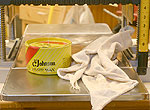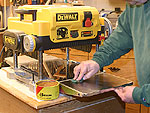This is a Veteran Owned site
 |
If you think something is wrong with your planer rollers, read this story! The answer may be easier than you thought! Click image to enlarge |
Waxing Planer Tables
A surprising "fix" for suspected feed roller problems
Text & Photos by Tom Hintz
Over the last few months, a rash of emails from woodworkers suspecting problems with the feed rollers of their relatively new planers revealed a common problem with a simple fix. As occasionally happens, what appears to be one problem turned out to be something completely different.
Many of these emails reported gradual to sudden reduction in the efficiency of their feed roller systems on relatively new planers. Some stated the material simply would not feed through the planer without pushing or pulling manually. While feed rollers can and do need occasional cleaning to rid them of dust buildup (wiping with a rag dampened with alcohol works) this contamination seldom cause the feed system to fail this badly. After working through this feed problem with several woodworkers, we found the problem was actually on the table itself, not the roller system.
Modern planers have a considerable amount of pressure applied to the wood by the feed rollers to help reduce snipe, the dishing out of the first and/or last few inches of the material, and to keep the board stable as it goes through the machine. That pressure creates a huge amount of friction between the board and table that can overcome the feed rollers, particularly when the planed face of the board is in contact with the table. Now that the board is flat, the contact area between it and the planer table is maximized, creating the most friction. If the surface of the table is not slick enough, the feed rollers can't keep the wood moving.
 |
For most complaining of feed roller problems, applying a good coat of wax to the tables was the fix. This simple procedure should be part of your regular planer maintenance. Click image to enlarge |
A coat of non-silicone wax on the table surface can be all that is needed to restore the performance of the feed system. I use Johnson's Paste Wax and have had very good results. Rub a light coat on the table, let it dry until it begins to haze and then polish it out with a clean cloth. Instant roller function!
Any mass-produced machine can and will have occasional problems, but waxing the table of your planer is an easy, cheap way to eliminate that possibility and make life easier for your feed roller system in the process.
Have a comment on this story? - Email Me!
All written, photographic and drawn materials are property of and copyright by NewWoodworker.com LLC 2000-2019. Materials may not be used in any way without the written permission of the owner.


